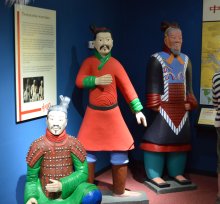|
Amenhotep II Obelisk (Durham University)
|
|
|
| Present Site: | Oriental Museum, Durham University, Durham, Northern England (Indoor exhibition) N 54°45'49.6"(54.763791) W 1°34'52.8"(-1.581326) |
| Pharaoh: | Amenhotep II (New Kingdom 18th Dynasty, Reigned 15 Century BC) |
| Measurement: | 2.15 m for obelisk alone 2.335 m including pedestal |
| Weight: | 350 kg for obelisk alone 430 kg including pedestal |
| Stone: | Red granite |
About the Site:
Durham is a historic city located in Northern England. Durham cathedral and the castle are both designated a World Heritage Site by UNESCO in 1986. University was founded in 1832, is a traditional collegiate university similar to Cambridge and Oxford which consists of 16 colleges currently.
We may miss the building of Oriental Museum, since it's smaller than the building of "Teikyo University of Japan in Durham" which is opposite side of the museum and eye-catching for us.
 The University in the wood
The University in the woodView from the way from the railroad station For high definition image, please click the picture |
Oriental Museum of Durham University is relatively new museum that was opened in 1960, that exhibits the collections of Ancient Egypt, China, Tibet, Japan, etc.
The colorful replica of "Terracotta Army" (from Ancient China) surprises us. It was probably colored when it was made, because I confirmed the small spot of color when I visited Xi'an, China. But such flashy colored pottery figurine is unsuitable for my feeling. Such decoration may be considered for the visitors of primary school children in order to let them understand easily and feel friendliness.
The obelisk is exhibited at the center of the backroom of 2 Egyptian Rooms. White limestone small obelisk is also exhibited at right side, which is inscribed horizontally with no cartouche (name of pharaoh with circle). See the photo below.
Since the museum is relatively small, 90 minutes or so is enough for observing all the exhibition. So I made a quick turn to London after I looked the obelisk. I would recommend you to visit the World Heritage Sites; the cathedral and the castle, not only the Oriental Museum, if you have more time.
Cathedral and Harry Potter: The Durham Cathedral is also known as the location site of the first movie of "Harry Potter" Series. The scenes in this movie "Harry Potter and the Philosopher's Stone", Harry walks with his white owl, Hedwig, through a snowy cloister courtyard, Hogwarts walks the passage, the school room for McGonagall's transfiguration were took in this cathedral.
The station that the "Hogwarts Express" departs is the King's Cross Station in London. While I was waiting for the train for Durham, I went around in the station. Since there is no platform between #9 and #10 in fact, the platform between #4 and #5 would be the location site for the movie. Platform 9 3/4 was a picture spot for the Harry Potter fans, and about 200 people were waiting in line, a several station staff were serving at the spot. At the wall, the half luggage cart and Hedwig (while owl) in birdcage were displayed, and the Gryffindor scarf was rented for the fans who wanted to take pictures.
 Flashy colored pottery figurine
Flashy colored pottery figurine
|
 Platform 9 3/4
Platform 9 3/4
|
How to Get There:
Durham is about 400 km north of London. The train reaches with 3 hours which is convenient although the long distance. However, the railroad station is NW far out from the center of Durham. It takes about 40 minute walk from the station to the University or Durham Castle. So, using a taxi is recommended, the fare is about 5 pounds one way.
About the Obelisk:
This obelisk was erected by Amenhotep II (New Kingdom 18th Dynasty, reigned 15 Century BC), and found in early 19th century in Elephantine Island on the River Nile, front of Aswan.
Although the first Nome of ancient Upper Egypt was located in this island, no remarkable antiquities remain other than the "Nilometer" and a ruin of port. However, many stones inscribed the name of kings were found in this island, this obelisk was one of such discovered stones.
Duke Algernon Percy (the 4th Duke of Northumberland, Formerly known as Lord Prudhoe) often traveled Egypt, and formed the "Duke Algernon Collection" with his may findings. When he visited the island durin the 3rd travel for Egypt in 1838, this obelisk was presented to him from the Egyptian viceroy, Mohammed Ali, and added to the collection.
The "Duke Algernon Collection" was stored in the tower of the Alnwick (pronounced "Annick") Castle, which is the principal seat of the Duke of Northumberland. The obelisk was carried into to this tower in 1840.
Then, for a certain period (a half century, probably from 1870s to 1920s) the obelisk was separately kept in Robert Adam's Great Hall of Syon House (London residence of Duke Northumberland) at Brentford, Middlesex, now part of the London metropolitan area. Then, the obelisk was kept in Alnwick Castle again. In 1950, all the "Duke Algernon Collection" including this obelisk was sold to the University of Durham, which is located near Alnwick.
This obelisk is 2.15 meters high, and has an inscription one side only, the other sides having been left plain. Since the "pyramidion" (pyramid cap) and the inscription are painted in gold color, the names of Horus, at enthronement, and at birth of Amenhotep II are clearly seen.
There is no other obelisk with gold painted hieroglyph, but it's said that the "pyramidion" was shining with golden color when the obelisk was erected. The Oriental Museum states that the gold was painted after the obelisk was acquired by the Duke Algernon, because the gold color remains very clearly.
This obelisk was made as a "pair" as usual. Other obelisk was found as the building material of a house in Elephantine Island. This was returned in 1920 and added to the collection of Egyptian Museum in Cairo, and transferred to the Nubian Museum when it was established. Currently this obelisk is displayed in the garden of the Museum. The website of the Oriental Museum says; other pair of obelisk is the Egyptian Museum of Cairo, but it's wrong. The correct information would not be conveyed to the Oriental Museum.
Exhibition in Japan: This obelisk is only one ancient Egyptian obelisk which was exhibited in Japan. The obelisk was exhibited the "The Beauty of Ancient Egypt" Exhibition which was held in 2008 with the collections of Eton College and the Oriental Museum of Durham University. This was held in Ancient Orient Museum (Tokyo), MOA Museum (Atami), Utsunomiya Museum, Hamamatsu-City Museum, Matsuzakaya Museum (Nagoya), and Daimaru Museum KOBE (Kobe). The British Press says, almost 200,000 people visited and earned about 60,000 pounds.
Small Obelisk of Amenemhat: The above mentioned white limestone small obelisk was also one of "Duke Algernon Collection". The website of the Oriental Museum says; this is the obelisk of Amenemhat, Middle Kingdom 13th Dynasty, reigned B.C. 18 Century.
75.5 cm high, weighted 18 kg. This was probably stored indoor or in the sepulcher because it's in white and beautiful. It was uncovered in Abydos of Upper Egypt.
Notes for Pictures:
I got a permission for using a flash light as the lighting of the exhibition room was dark. Amenhotep II Obelisk has the inscription on one side. So, I don't post the pictures of other 3 sides.
Instead, another pair obelisk in Nubian Museum, and white limestone small obelisk in Oriental Museum of Durham University are posted here. (Both are mentioned above.)
Aug. 3, 2014 in Durham, Aug. 7, 2014 in Aswan by Hiroyuki Nagase (For high definition image, please click the picture) | ||||||
Copyright Hiroyuki Nagase nagase@obelisks.org and Shoji Okamoto okamoto@obelisks.org